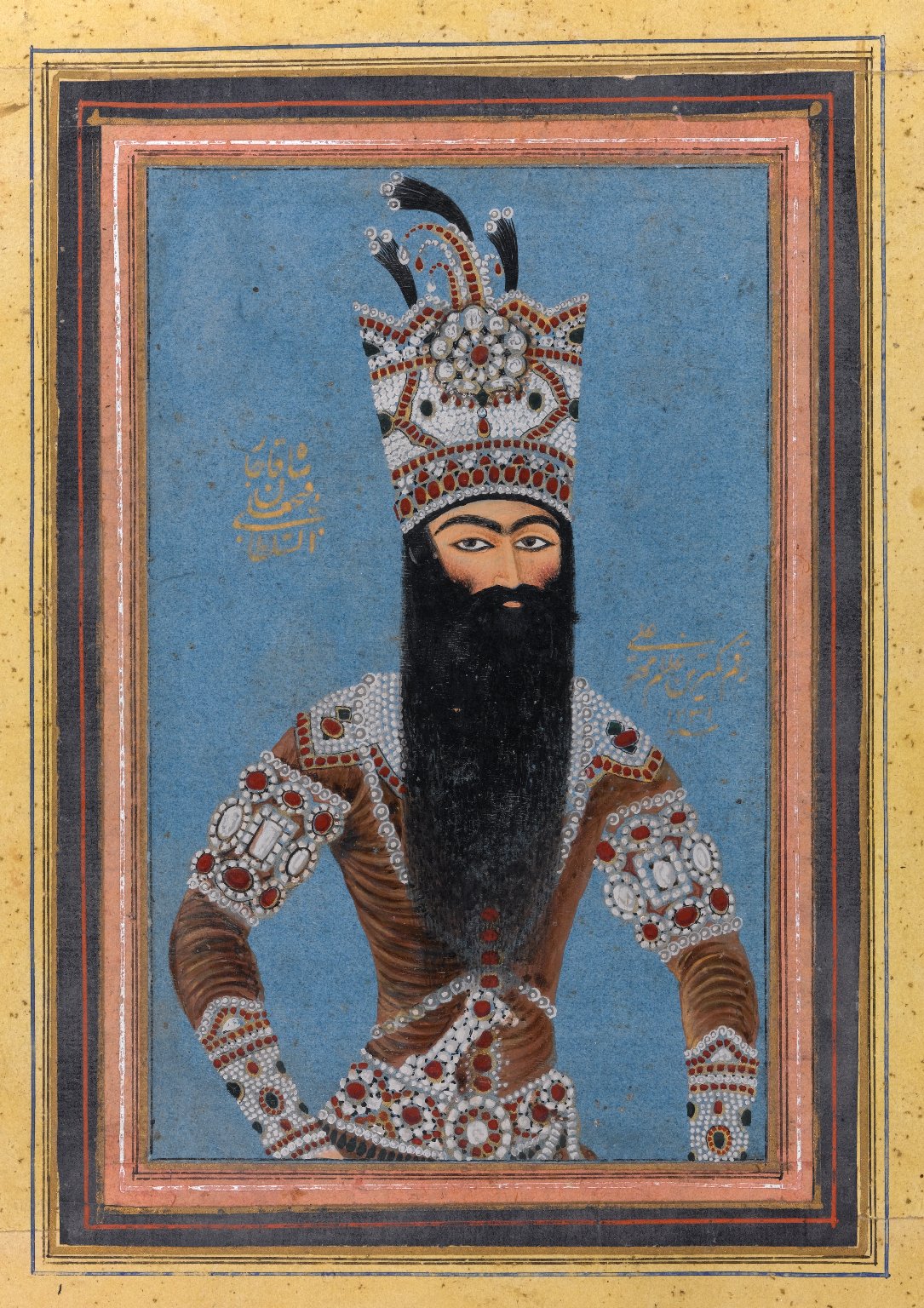Mihr Ali on:
[Wikipedia]
[Google]
[Amazon]

 Mihr 'Ali ( Persian: مهر علی نقاش;
Mihr 'Ali ( Persian: مهر علی نقاش;
Painting of Fat'h Ali Shah Qajar by Mihr Ali
{{DEFAULTSORT:Mihr Ali Year of death missing Court painters 18th-century Iranian painters 19th-century Iranian painters Year of birth uncertain People of Qajar Iran

 Mihr 'Ali ( Persian: مهر علی نقاش;
Mihr 'Ali ( Persian: مهر علی نقاش; fl.
''Floruit'' (; abbreviated fl. or occasionally flor.; from Latin for "they flourished") denotes a date or period during which a person was known to have been alive or active. In English, the unabbreviated word may also be used as a noun indicatin ...
1795-''post'' 1830) (also spelt Mir Ali or Mehr Ali) was one of the great royal painters of the Persian court during the reign of Fat'h Ali Shah Qajar
Fath-Ali Shah Qajar ( fa, فتحعلىشاه قاجار, Fatḥ-ʻAli Šâh Qâjâr; May 1769 – 24 October 1834) was the second Shah (king) of Qajar Iran. He reigned from 17 June 1797 until his death on 24 October 1834. His reign saw the irr ...
, and is regarded as the most notable Persian portraitist of the early part of this reign.http://www.sothebys.com/app/live/lot/LotDetail.jsp?lot_id=159545074 Mihr Ali was one of the foremost painters of the early period of Qajar art.
Mihr 'Ali's chief skill was his ability to capture the portrait-sitter's grandeur and power, and as such he became a favourite painter of the Shah. Mihr 'Ali produced at least ten full-size oil paintings of Fat'h Ali Shah, one of the earliest of which was probably sent as a present to the amirs of Sind in 1800. A further portrait, of the Shah enthroned, was sent to Napoleon. Mihr Ali's finest portrait is an 1813–4 work, regarded by some as the finest Persian oil painting in existence. It shows a full-length portrait of the King wearing a gold brocade robe and a royal crown, holding a jewelled staff.
Fat'h Ali Shah commissioned great numbers of lifesize portraits of himself and his sons, works which formed the backdrop to court ceremonies. The works, painted by Mihr 'Ali and his predecessor as court painter, Mirza Baba, portrayed Fat'h Ali Shah in his manyb stately roles, and were intended to show his power as a ruler rather than to be realistic portraits. As a result, the works are heavily stylised, are painted in rich, deep tones, and are filled with symbols of power.
Other important works by Mehr 'Ali include a series of portraits of Persian rulers and figures from the '' Shahnameh'', commissioned by Fat'h Ali Shah as decoration for the 'Imarat-i Naw Palace in Isfahan
Isfahan ( fa, اصفهان, Esfahân ), from its Achaemenid empire, ancient designation ''Aspadana'' and, later, ''Spahan'' in Sassanian Empire, middle Persian, rendered in English as ''Ispahan'', is a major city in the Greater Isfahan Regio ...
. This series of works was notable enough to be mentioned in the reports of many of the European travellers to Isfahan, such as James Morier
James Justinian Morier (15 August 1782 – 19 March 1849) was a British diplomat and author noted for his novels about the Qajar dynasty in Iran, most famously for the ''Hajji Baba'' series. These were filmed in 1954.
Early life
Morier was bor ...
(in ''A Journey through Persia in the years 1808 and 1809'', published in 1812), Sir William Ouseley in 1812 (in ''Travels into various Countries of the East'', published in 1823), and Charles Texier
Félix Marie Charles Texier (22 August 1802, Versailles – 1 July 1871, Paris) was a French historian, architect and archaeologist. Texier published a number of significant works involving personal travels throughout Asia Minor and the Middle Eas ...
(in ''Description de l'Arménie, la Perse et la Mesopotamie'', published in 1852). Until 1985, it was thought that all of the paintings in this series had been destroyed, but three have since been discovered and authenticated, those being portraits of Afrasiyab, Genghis Khan
''Chinggis Khaan'' ͡ʃʰiŋɡɪs xaːŋbr />Mongol script: ''Chinggis Qa(gh)an/ Chinggis Khagan''
, birth_name = Temüjin
, successor = Tolui (as regent)Ögedei Khan
, spouse =
, issue =
, house = Borjigin
, ...
, and Kay Khusraw
Kay Khosrow ( fa, کیخسرو) is a legendary king of Iran of Kayanian dynasty and a character in the Persian epic book, ''Shahnameh''. He was the son of the Iranian prince Siavash who married princess Farangis of Turan while in exile. Be ...
, though the Kay Khusraw portrait does not exist in its full form but has been reduced to only some 80% of its original size. Despite this, it sold at auction at Christie's in London in 2007 for £54,000 ($US 107,500). The other two works are also in private hands, having been auctioned by the same company in 1987.
Mihr 'Ali was also a capable teacher, his pupils including the noted painter Abul-Hasan Ghaffari.https://books.google.com/books?id=HAROVoRQluoC&pg=PA146&lpg=PA146&dq=%22Mihr+ali%22+artist&source=bl&ots=wgXc2fNt8b&sig=N_pCRMvO7lLbKIurhQ8voTWnSYI&hl=en&ei=dyDGTLrjAoXZcZSUjK0O&sa=X&oi=book_result&ct=result&resnum=5&ved=0CCYQ6AEwBA#v=onepage&q=%22Mihr%20ali%22%20artist&f=false
References
External links
Painting of Fat'h Ali Shah Qajar by Mihr Ali
{{DEFAULTSORT:Mihr Ali Year of death missing Court painters 18th-century Iranian painters 19th-century Iranian painters Year of birth uncertain People of Qajar Iran